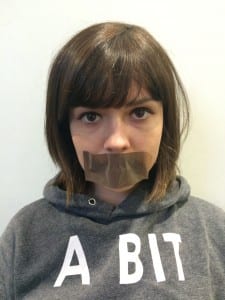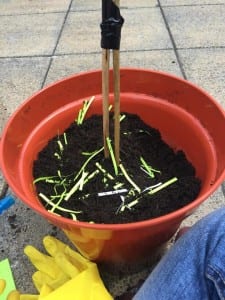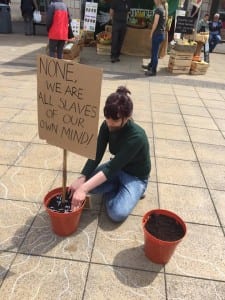Framing Statement:
Over the past semester, we have focused on Site Specific Performance. My group used the Lincoln City High Street as their performance space. On the 5th of May 2016, our group performed our Site Specific piece H2O on the Lincoln High Bridge. This blog will examine the methodologies and processes, which were undertaken to configure our final performance. One of our major influences was Mark Augé’s theory of places and non-places. Augé defines a place as having a, “relational, historical and concerned with identity” (Auge, 1995, 77). He refers to non-places as areas used to get one’s destination (Auge, 1995). Our group used Augé’s theory of a non-place, to revitalise the area and make it a place again. Further inspiration came from Joanne Bob Whalley and Lee Miller’s art piece Partly Cloudy Chance of Rain (2002). The couple challenged non-places, by renewing their wedding vows in a M6 motorway service station, thus turning a non-place into a place with meaning. They claim the,
“… process of reclaiming the motorway, inscribing it with its hidden narratives. This was an attempt to bypass its super modern position as a non-place, and return it… to the position of an anthropological place” (Kershaw and Nicholson, 2011, 69).
This is reiterated by Patrice Pavis’ statement,
“The insertion of a classical or modern text in this found ‘space’ throws new light on it, gives it an unsuspected power… the place and the purpose for being there” (Pavis, 1998, 337-338).
Such is the goal for our High Bridge performance. In the 18th century, the High Bridge incorporated a fountain, named The Obelisk. The History of water was influential in the decision to use water as our focus, thus the name H20.

The aim of H2O was to explore how water is taken for granted today. Our approach was to objectify water, in order to engage the public to see water in a different way. Such inspiration was drawn from Michael Fried’s theory of ‘objecthood’, which changes the norms of how water can be presented. Further influence came from Mierle Laderman Ukeles’ Maintenance Art, therefore our performance provided a service by recreating the functions of the Obelisk. Further, through our creation of the Obelisk, we presented a sense of teamwork and unity. Additionally, the appearance of a work-force could present interesting visuals for our passing audiences, causing members of the public to stop and engage with us. Thus, creating a sense of community within the High Street, and transforming the High Bridge a place again as defined by Mark Augé.
Process: The History of the Bridge
Firstly, our group began by researching the history of the High Bridge, as we wanted to relate our site to the space. David Ross wrote that the High Bridge, which sits over the River Witham, was constructed in 1160 AD. The Bridge, over its lengthy history, once held a church that was a memorial to Thomas Beckett, built in 1235 AD in remembrance of his assassination. This church stood for over six hundred years, until 1763 when the church was replaced by a fountain. This fountain became the main source of water for Lincoln High Street, named the Obelisk (Ross, 2016).

Process: Connections Started to Form
In relation to Augé’s work of non-places, the Obelisk seemed a good starting point in creation of our performance. The connection being, while the Obelisk had a presence on the High Bridge, people purposely travelled to the High Bridge using the Obelisk as a source of water. Augé states expanding places by explaining places are “promoted to the status of ‘places of memory, and assigned to a circumscribed and specific positions” (Augé, 1995, 78). This statement is relatable to the Obelisk, as whilst it was present on the High Bridge people had a purpose to travel for their source of water. However, since the Obelisks absence on the High Bridge people’s reasons for travelling there diminished.
Over the last hundred years, the High Bridge has transcended from being a ‘place’ with a purpose (where people collect their water from) to being a ‘non-place’. In present day, the Bridges only purpose is as a pass over to each side of the High Street. This brought us to one of our main influences, Joanne Bob Whalley and Lee Miller. The couple challenged what is considered a “place” and a “non-place” through Partly Cloudy Chance of Rain (2002). This piece challenged what the service station would be categorised as by Augé. This inspired our performance, as we wanted to follow Joanne Bob Whalley and Lee Miller’s ideas and alter the High Bridges spatial status.
Our Early Beginnings
Now we had desired purpose for our piece, we began to question how the space could be actively used. As a starting point, we looked into Carl Lavery’s (2005) 25 instructions for performance in cities, to see if the rules could give a different interpretation for our site. Our group was interested in rule 21, which Lavery states as “situations designed for a mass audience of ‘spect-actors” (Lavery, 2005, 336). To experiment with this rule and individuals engagement on the bridge, we decided to adopt Lavery’s instructions. We used signs such as “Free Hugs” And “If Aliens were to land in Lincoln where would they land?”

From this experimentation we realised it engaged the public’s interest, gathering an audience. People were incredibly responsive, answering the questions and highlighting their creativity. Over a series of different signs, it was clear audiences had become drawn into our breaking of the norm. From this, we knew we could engage the public, however, our group wanted to make sure that our performance had significant meaning to the High Bridge.
We started to draw meaning to our performance, engaging people and giving meaning to our site (the High Bridge), to make it a place once more. Our group was intrigued by Lavery’s fifth rule, “Create an installation of the city out of lost objects and the recorded testimonies of local people” (Lavery, 2005, 335). We instantly noticed a correlation between this rule and our site, more directly a link to the Obelisk. Lavery speaks about lost “objects” which instantly relates to the Obelisk being a crucial, and lost, part of Lincoln’s history. After the Obelisk was dismantled, indoor plumbing became more common, and the public began to take water for granted. Thus, we created the link ‘what people need to live’ and how water is a main factor. Within Michael Fried’s Art and Objecthood, he believes that taking an “Object” and stripping it down to its barest form unlocks a higher meaning, creating no meanings to various objects (Fried, 1998).
Our group wanted to explore water as an object, instead of just water we used bottled water for this investigation, as it was more practical. This exploration began by asking people to write down, “In one word what do you value the most in life?”

Lavery rule states, “create an installation piece”, this was done by writing peoples answers on the water bottles and placing them on the streets. This presented our underlying message that individuals take water for granted over other modern day necessities, as none of the answers involved water being a necessity to live. Thus, we took away the labels, and allowed people to write their own idea of a ‘necessity’, as of such when people stepped back they could see the bigger picture of what people need to live, presented on a genuine life source. Furthermore, this would achieve our goal of creating meaning in reference to the Obelisk, while also encouraging the community to openly speak about water.
Process: Our Turning Point
We believed our final idea had been finalised. However, we received feedback from our tutors and although they enjoyed the concept of our performance, there were issues. They believed the concept would not be cleared by the local council due to the water bottles being a trip hazard, and that we were not physically present enough in the performance. This led us to step back and rethink our idea of water.
Process: The beginning of H2O
Our group all agreed the Obelisk and the importance of the water still heavily informed our piece. However, from feedback we had to present this in a more physical way. We began rethinking how we can represent water and the Obelisk, and continue the idea of ‘objecthood’ proposed by Michael Fried. We started thinking instead of the water bottles, we could think of the Obelisk as an object. We considered the physical representation of the Obelisk, in which we could recreate its functions. In relation, we started to research into practitioners who could aid formation of the psychical representation of the Obelisk. Thus, we researched into the works of Mierle Laderman Ukeles’ Maintenance Art, as discussed in Kelly Rafferty’s article Regeneration: Tissue Engineering, Maintenance, and the Time of Performance. Maintenance Art. Maintenance art takes labour and public services and applies them to an Art form, which shows how work like roles in society are used in a theatrical process (Rafferty 2012). Rafferty states, “Instead of naturalizing or essentializing certain kinds of labour… that goes in to assigning certain jobs to certain people, valuing some kinds of work over others, making some work visible and other work invisible” (Rafferty, 2012, 91). This information helped our group to begin to apply the idea of creating a service to the High Street, taking influence from the theories behind Maintenance Art.
We began to look further into this style of art and discovered an art piece entitled The Berlin Puddle as wrote about by the art blog Artterritory. Pieroth’s work in 2001 consisted of taking a puddle from Isartorplatz Park, which she wanted to place in a different setting, thus changing the purpose of the puddle. To do this, she transported the puddle to a Berlin Art Gallery by plastic jugs; this changed the way the puddle was seen and its overall purpose (Iltnere, 2013). Both Pieroth and Ukele inspired our group’s progress, we wanted to draw attention to our performance base (the High Bridge) through openly working with water in re-creating the Obelisk.
Our group was able to make a correlation behind the Obelisk, by making a process, which followed the same principle of how the Obelisk produced water. As a group, we started spending time with water, experimenting with it in different ways; pouring, giving it out and taking water out of the Brayford pool. After performing such experiments, the idea of becoming a water filter progressed, giving our group a new idea on how to present the Obelisk in a new light.

Finally, we decided to create a five step purifying system, which our group would form as a team. Each member of the group worked at a station, be it; Bucketing water out the Brayford, guarding the water storage, transporting the water back into the Brayford, filtering the water through three separate jugs and finally cleaning the high bridge and pouring the water back into the Brayford. These actions made our group focus as a unitary system, making a service once again to the Brayford. We would create a component interacting with the water, and further engage with passing audiences in different ways. Our main objective was to make the public think about water through our actions, and openly discuss water with us during the process. Although, hopefully without discussing the obelisk, allowing the audience to think more deeply about the water. Thus, creating a meaning within the space and making the High Bridge a place again.
Figure 6: H2o Performance. (Peck, 2016).
Reflection: H2O
On the 5th May 2016, we performed our Site Specific Performance H20, the aim of the performance was to achieve audience interaction which would engage the public to openly think about water and their personal relationships with water. On personal reflection of the day, we were able to achieve a reaction and interaction in three different ways visually, practically and non-practically. Our group noticed our peak time was three o’clock, large groups gathered to watch our performance, and began asking us questions about the performance. Furthermore, people were coming together in unity discussing openly what we were presenting. The public embraced speaking openly, and the majority of conversations each group member had with the public ended with the public understanding the reasons behind the performance, thus showing how audiences engaged with us practically.

Furthermore, the public interacted with other members of the public throughout the performance, creating a sense of community. After we spoke to an individual, they would begin explaining the process to other members of the audience who were watching the performance; such shows how our site performance engaged people non-practically.
The public interacted by touching, examining and listening. We were able to gain attention of people passing by, who did not stop, but instead became drawn to us as they passed, and these were our visual audience. However, I believe this was achieved due to our group’s dynamics during the performance. Although, such deep interaction of the public also presented problems. People began being so involved in the performance they began being unsafe, we had to stop people from touching or drinking the water. Thus, we had to intervene on many different occasions. Although, we were prepared enough to stop these incidents, it could have been resolved with more water guards in place.
Throughout the performance, we used the correct level of energy, this aided us in being visually interesting and holding the audience’s attention. However, the energy was difficult to maintain over the performance period. Personally, it was apparent each member of the group had begun showing fatigue as the day went on. This effected our hold of the audience, as we did not have the same eye-catching energy.
Another weakness of our performance is the backlog of water created at different stations causing us to slow, and eventually stop. In future, to keep the momentum going throughout we would need to make sure that we had more filter jugs and spray bottles. By doing this, we would be able to keep the process going for a longer period.
In reflection, it is clear to see many different attributes affected our performance. Nevertheless, our group set out with the goal of trying to make a site specific performance that grabbed the audience’s attention, as well as gave meaning to our site. We believed that throughout our process we achieved this goal, by gathering people back to the High Bridge similar to when the Obelisk still stood. Therefore, in our site specific performance we were able to an achieve turning a ‘non-place’ back into a ‘place’ for one day.
Works Cited
Augé, M. (1995) Non-Places: Introduction to an Anthropology of Supermodernity. London: Verso.
Cummings, W. (2016) Site Specific Gang Page [Facebook]. 16 March. Available from https://www.facebook.com/photo.php?fbid=10207559524963870&set=pcb.914679068639847&type=3&theater [accessed 10 May 2016].
David, R. (2013) High Bridge And The Glory Hole, Lincoln. London: Britain Express. Available from http://www.britainexpress.com/counties/lincs/properties/Glory-Hole.htm [accessed 3 May 2016].
Fried, M. (1998) Art and Objecthood. Chicago: University of Chicago Press.
Iltnere, A. (2013) What Elmgreen & Dragset Did With Munich, Or, The Max And Moritz Of Contemporary Art. Arterritory.com. Available from http://www.arterritory.com/en/texts/interviews/2439-what_elmgreen_dragset_did_with_munich,_or,_the_max_and_moritz_of_contemporary_art/. [Accessed on 9 May 2016].
Kershaw, B. and Nicholson, H. (2011) Research Methods In Theatre And Performance. Edinburgh: Edinburgh University Press.
Lodge, J. (2016) H20 Event Page [Facebook]. 11 May. Available from https://www.facebook.com/photo.php?fbid=10208225449226264&set=pcb.815141141924856&type=3&theater [accessed 11 May 2016].
Lodge, J. (2016) Site Specific Gang Page [Facebook]. 21 February. Available from https://www.facebook.com/photo.php?fbid=10207530515093345&set=pcb.901307489977005&type=3&theater [accessed 10 May 2016].
Lavery, C. (2005): Teaching Performance Studies: Instructions For Performance In Cities. Studies in Theatre and Performance, 25 (3) 229-238.
Pavis, P. (1998) Dictionary of the Theatre: Terms, Concepts, and Analysis Toronto: University of Toronto Press
Pearson, M. (2010) Site-Specific performance. London: Palgrave Macmillan.
Peck, B. (2016) H20. [Online] Available from: https://www.youtube.com/embed/ejgHF15Mpl8. [Accessed 11 May 2016]
Powell, S, J. (2016) H20 Event Page [Facebook]. 11 May. Available from https://www.facebook.com/photo.php?fbid=10208225449386268&set=pcb.815141141924856&type=3&theater [accessed 11 May 2016].
Rafferty, K. (2012) Regeneration: Tissue Engineering, Maintenance, and the Time of Performance. TDR: The Drama Review, 3 (56) 82-99.
Valentine, K. (2016) H20 Event Page [Facebook]. 5 May. Available from https://www.facebook.com/photo.php?fbid=10206422177177753&set=pcb.812336468871990&type=3&theater [accessed 10 May 2016].
Walls, A. (2016) H20 Event Page [Facebook]. 5 May. Available from https://www.facebook.com/photo.php?fbid=1624060364584896&set=pcb.812328255539478&type=3&theater [accessed 10 May 2016].



























